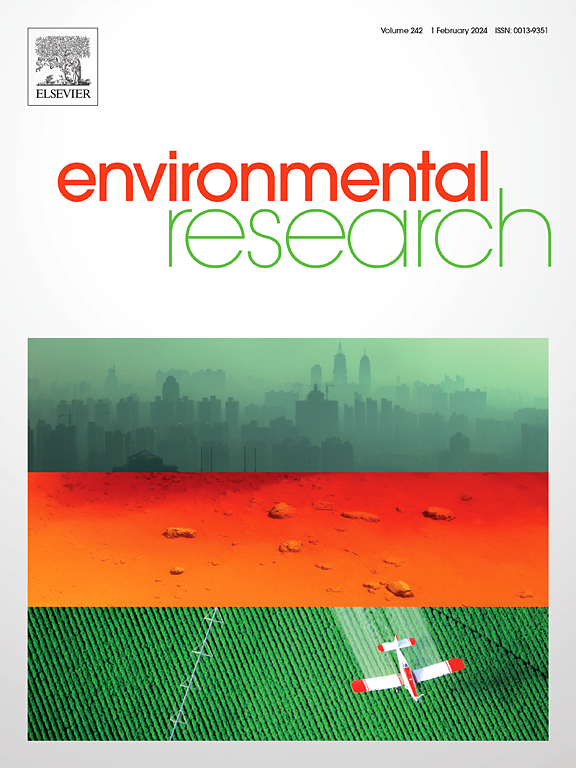Effects of bicarbonate on electro-bioremediation of phenanthrene-contaminated groundwater
IF 7.7
2区 环境科学与生态学
Q1 ENVIRONMENTAL SCIENCES
引用次数: 0
Abstract
Electro-bioremediation under anaerobic conditions is an effective approach for refractory organic matter removal in groundwater. Bicarbonate (HCO3−) is an inorganic carbon source and electron acceptor in groundwater, however, the influencing mechanism of HCO3− on pollutant removal of electro-bioremediation remains unclear. Herein, the effects of HCO3− concentration on electro-bioremediation of phenanthrene (PHE)-contaminated groundwater were investigated. HCO3− could facilitate the PHE degradation while an HCO3− concentration of higher than 1000 mg L−1 had a significant inhibition effect. Among the HCO3− concentration of 100–5000 mg L−1, the highest PHE degradation efficiency of 75.04–80.18 % was achieved in the electro-biochemical reactor with 500 mg L−1 HCO3−. The PHE removal efficiency was negatively correlated with the current density during the electro-bioremediation process, due to the effect of HCO3− concentrations on the electrolyte conductivity in the reactors. The electro-bioremediation process could increase the richness of diversity of microbes. Methanomethylovorans and the PHE-degrading bacteria including Pelolinea, Clostridium sensu stricto 5, Diaphorobacter, Methyloversatilis and Flavobacterium were the main microbes involved in PHE degradation. Of them, Methanomethylovorans was significantly positively correlated with the PHE removal efficiency. The potential metabolic function analysis revealed that the bacterial chemotaxis, flagellar assembly, carbohydrate metabolism and ABC transporters were prompted with the addition of HCO3−, while they were inhibited with the increasing HCO3− concentration. These findings suggested that electro-bioremediation technology was suitable for the remediation of polycyclic aromatic hydrocarbons such as PHE-contaminated groundwater in low bicarbonate areas.
碳酸氢盐对菲污染地下水电生物修复的影响
厌氧条件下的电生物修复是去除地下水中难降解有机物的有效途径。碳酸氢盐(HCO3−)是地下水中的无机碳源和电子受体,但HCO3−对电生物修复中污染物去除的影响机制尚不清楚。本文研究了HCO3−浓度对菲污染地下水电生物修复的影响。HCO3−能够促进PHE的降解,而浓度大于1000 mg L−1的HCO3−具有显著的抑制作用。在100 ~ 5000 mg L−1 HCO3−浓度下,500 mg L−1 HCO3−的电生化反应器中,PHE降解效率最高,达到75.04 ~ 80.18%。在电生物修复过程中,由于HCO3−浓度对反应器中电解质电导率的影响,PHE的去除效率与电流密度呈负相关。电生物修复过程可以增加微生物的丰富度和多样性。甲烷甲基化菌以及Pelolinea、Clostridium sensu stricto 5、Diaphorobacter、methylovanlis和Flavobacterium是参与PHE降解的主要微生物。其中,Methanomethylovorans与PHE去除效率显著正相关。潜在代谢功能分析表明,HCO3−的加入促进了细菌的趋化性、鞭毛组装、碳水化合物代谢和ABC转运体,而随着HCO3−浓度的增加,它们被抑制。研究结果表明,电生物修复技术适用于低碳酸氢盐地区多环芳烃污染地下水的修复。
本文章由计算机程序翻译,如有差异,请以英文原文为准。
求助全文
约1分钟内获得全文
求助全文
来源期刊

Environmental Research
环境科学-公共卫生、环境卫生与职业卫生
CiteScore
12.60
自引率
8.40%
发文量
2480
审稿时长
4.7 months
期刊介绍:
The Environmental Research journal presents a broad range of interdisciplinary research, focused on addressing worldwide environmental concerns and featuring innovative findings. Our publication strives to explore relevant anthropogenic issues across various environmental sectors, showcasing practical applications in real-life settings.
 求助内容:
求助内容: 应助结果提醒方式:
应助结果提醒方式:


